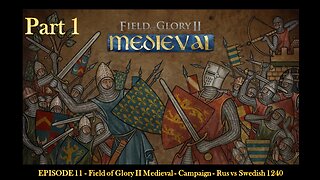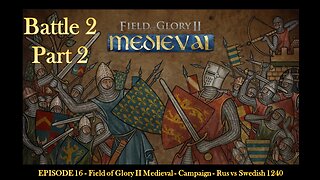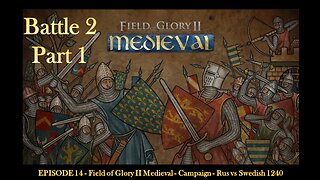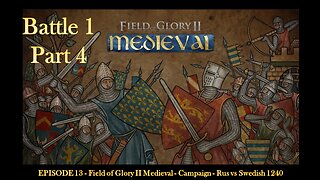Episode 1221: St King Eric of Sweden
King Eric of Sweden, born Erik Jedvardsson, was born around 1120 in Uppland, Sweden. He was a member of the royal house of Sweden and belonged to the influential Folkung dynasty. At a young age, Eric became a catholic and developed a deep devotion to his faith.
The Folkungs were a powerful noble family that played a significant role in Swedish history during the medieval period.
Eric's mother was Christina Björnsdotter, also known as Christina the Stommeln. She was the daughter of Björn the Houscarl, a member of the noble Hårdätten family. Christina was married to King Sverker I of Sweden, who was the reigning monarch at the time.
Eric's birth occurred around 1120, and he was likely raised in an environment that exposed him to the intricacies of politics, governance, and noble life. Growing up within the royal household, Eric would have received education and training befitting his status, preparing him for his future role as king.
The Folkung dynasty, to which Eric belonged, held considerable influence in Swedish politics. They were known for their ambitions to expand the power of the monarchy and promote the interests of the royal family. The Folkungs often clashed with other noble families, such as the Sverker dynasty, in their pursuit of political dominance.
Eric's ascent to the throne in 1150 marked a crucial moment for the Folkung dynasty, as it secured their hold on the Swedish monarchy. His reign represented a consolidation of power for the Folkungs, who would continue to exert influence over Swedish politics for generations to come.
At the beginning of Eric's reign, Pope Eugene III was the reigning pontiff. Eugene III served as pope from 1145 to 1153. He was succeeded by Pope Anastasius IV, who held the papacy from 1153 to 1154. Following Anastasius IV, Pope Adrian IV assumed the papal office from 1154 to 1159.
Eric's connection to the royal house of Sweden and his membership in the influential Folkung dynasty played a significant role in shaping his life and reign.
Side note for all history geeks:
Olaf Skötkonung (Scott-Kuu-Non): Olaf Skötkonung was a Swedish king who ruled during the late 10th century(900’s) and so 2OO years before Eric . He is considered the first Catholic king of Sweden
Missionaries and Influences: Besides Ansgar, other missionaries and religious figures played a role in spreading Christianity throughout Sweden. Missionaries from Germany and other parts of Europe ventured into Sweden, establishing churches and converting local populations. Monastic orders, such as the Benedictines and Cistercians, also contributed to the propagation of Christianity.
Political Factors: The conversion of Sweden was not solely a religious development but also had political motivations. Embracing Christianity brought Sweden closer to other Christian kingdoms and facilitated diplomatic ties and alliances. Conversion to Christianity also allowed Swedish rulers to consolidate their power and enhance their legitimacy.
It's important to note that the conversion process varied across different regions of Sweden, and pockets of paganism persisted even after the official acceptance of Christianity. The process of Christianization extended over several centuries, and its complete implementation took time.
Overall, the conversion of Sweden to Christianity was a complex and multifaceted process involving missionaries, political factors, and the gradual acceptance and adoption of the new faith by the population.
Done with the side note. HA
In 1150, Eric ascended to the throne as the king of Sweden. As a ruler, he was known for his wisdom, piety, and commitment to justice. Eric was devoted to upholding the laws and promoting Christianity throughout his kingdom. He worked towards establishing a strong central authority and sought to consolidate his power.
During his reign, Eric faced several challenges and conflicts. He engaged in military campaigns to defend and expand the territories of Sweden. Eric was particularly involved in conflicts against pagan tribes and neighboring kingdoms, aiming to protect Christian communities and spread the influence of the Church.
During a battle against the Finnish pagans in 1160, Eric was captured and taken prisoner. Despite his captivity, he remained steadfast in his faith and is said to have converted some of his captors to Christianity. Ultimately, he was executed by his captors in Uppsala, Sweden, in May 1160.He was only 40 years old.
Following his death, many miracles were attributed to Eric, and his cult as a saint began to develop. He was posthumously recognized as a martyr and saint, known for his devotion to justice, Christianity, and the welfare of his people. Eric's relics were enshrined in Uppsala Cathedral, where they became the focus of pilgrimage.
Here are a few examples of the miracles associated with Saint Eric:
Healing Miracles: Many accounts claim that individuals who prayed to Saint Eric experienced miraculous healings. It was believed that he had the power to cure various illnesses and ailments, ranging from physical disabilities to terminal diseases. People sought his intercession for healing and reported remarkable recoveries.
Protection from Danger: Saint Eric was believed to provide protection and help in times of danger. It was said that he could shield people from harm and deliver them from perilous situations. There are tales of individuals who claimed that their lives were saved from accidents, attacks, or other dangerous circumstances through the intervention of Saint Eric.
Miraculous Intervention in Nature: Some legends attributed miraculous events in nature to Saint Eric. These stories often depicted him as having control over the elements or being able to influence the weather. It was believed that he could bring rain during times of drought or calm storms at sea, providing relief and assistance to those in need.
Conversion of Pagans: As mentioned earlier, Eric's captors in Finland were said to have been converted to Christianity through his influence, even in the face of his own impending martyrdom. This event was seen as a significant miracle and served to emphasize Eric's dedication to spreading the Christian faith.
These accounts of miracles contributed to the growth of a cult devoted to Saint Eric. People began to venerate him as a saint and sought his intercession in their prayers. Pilgrimages were made to his tomb, and relics associated with him were cherished and believed to possess healing properties.
The cult of Saint Eric continued to flourish over the centuries, and numerous churches and chapels were dedicated to him across Sweden. His feast day, May 18th, became a significant occasion for religious observances and celebrations. Today, although less prominent than in the past, Saint Eric remains an important figure in Swedish religious and cultural traditions.
In 1167, Eric was officially canonized by Pope Alexander III, becoming the patron saint of Stockholm, Sweden. His feast day is celebrated on May 18th.
-
 9:06
9:06
CatholicReboot
3 months agoEpisode 1899: St Ethelbert King of Kent
141 -
 12:38
12:38
CatholicReboot
6 months agoEpisode 1645: St Leopold of Austria
65 -
 38:23
38:23
CAPT JAKE's Sim Racing, and Gaming
10 months ago $0.01 earnedEPISODE 11 - Field of Glory II Medieval - Campaign - Rus vs Swedish 1240 - Part 1
160 -
 51:52
51:52
CAPT JAKE's Sim Racing, and Gaming
10 months agoEPISODE 13 - Field of Glory II Medieval - Campaign - Rus vs Swedish 1240 - Part 3
155 -
 54:36
54:36
CAPT JAKE's Sim Racing, and Gaming
10 months agoEPISODE 12 - Field of Glory II Medieval - Campaign - Rus vs Swedish 1240 - Part 2
148 -
 47:10
47:10
CAPT JAKE's Sim Racing, and Gaming
9 months agoEPISODE 16 - Field of Glory II Medieval - Campaign - Rus vs Swedish 1240 - Battle 2 - Part 2
419 -
 53:46
53:46
CAPT JAKE's Sim Racing, and Gaming
9 months ago $0.01 earnedEPISODE 15 - Field of Glory II Medieval - Campaign - Rus vs Swedish 1240 - Battle 2 - Part 1
422 -
 49:19
49:19
CAPT JAKE's Sim Racing, and Gaming
9 months agoEPISODE 14 - Field of Glory II Medieval - Campaign - Rus vs Swedish 1240 - Battle 1 - Part 4
429 -
 49:05
49:05
CAPT JAKE's Sim Racing, and Gaming
9 months ago $0.03 earnedEPISODE 17 - Field of Glory II Medieval - Campaign - Rus vs Swedish 1240 - Battle 2 - Part 3
504 -
 48:40
48:40
CAPT JAKE's Sim Racing, and Gaming
9 months agoEPISODE 18 - Field of Glory II Medieval - Campaign - Rus vs Swedish 1240 - Battle 2 - Final
290